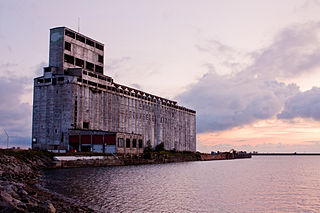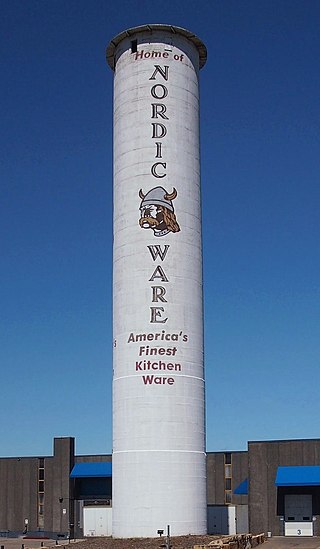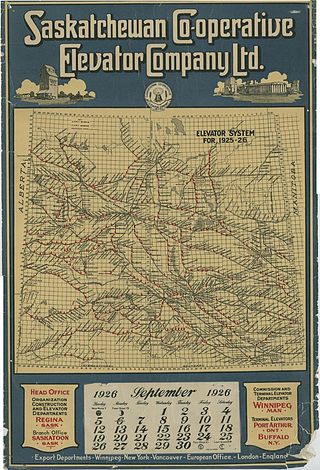Canada
USA

A grain elevator is a facility designed to stockpile or store grain. In the grain trade, the term "grain elevator" also describes a tower containing a bucket elevator or a pneumatic conveyor, which scoops up grain from a lower level and deposits it in a silo or other storage facility.

CHS Inc. is a Fortune 500 secondary cooperative owned by United States agricultural cooperatives, farmers, ranchers, and thousands of preferred stock holders. Based in Inver Grove Heights, Minnesota, CHS owns and operates various food processing and wholesale, farm supply, financial services and retail businesses. It also distributes Cenex brand fuel in 19 midwestern and western states as one of North America's largest c-store networks. It is a co-owner of Ventura Foods, a vegetable oil processor.
First International Bank & Trust (FIBT) started in 1910 as Farmers State Bank in Arnegard, North Dakota. In 1934 the bank moved its headquarters to Watford City, North Dakota, and changed the name to First International Bank. It is owned by Watford City Bancshares, Inc., which is owned by the Stenehjem family, and is a full service, independent community bank, a member of the FDIC, and an equal housing lender. First International Bank & Trust has 32 locations in North Dakota, South Dakota, Minnesota, and Arizona.

The Peavey–Haglin Experimental Concrete Grain Elevator is the world's first known cylindrical concrete grain elevator. It was built from 1899 to 1900 in St. Louis Park, Minnesota, United States, as an experiment to prove the design was viable. It was an improvement on wooden elevators that were continually at risk for catching fire or even exploding. Its cylindrical concrete design became the industry standard in the United States, revolutionizing grain storage practices. After its initial experiments, the Peavey–Haglin Elevator was never again used to store grain. Since the late 1960s it has been maintained on the grounds of the Nordic Ware company and is painted with their name and logo.

A wheat pool is a co-operative that markets grain on behalf of its farmer-members.

Manitoba Pool Elevators was a grain trade company founded in 1924. It became a subsidiary of the Saskatchewan Wheat Pool until November 1932, when the Pool declared bankruptcy. In 1998 Alberta Wheat Pool and Manitoba Pool Elevators merged to form Agricore Cooperative Limited. In 2001, United Grain Growers combined its business operations with Agricore Cooperative Ltd. and carried on business as Agricore United, a publicly traded company, no longer a farmer-owned cooperative. In 2007, Agricore United was taken over by the Saskatchewan Wheat Pool, another publicly traded company. The merged corporation was renamed Viterra.
The Manitoba Grain Growers' Association (MGGA) was a farmer's association that was active in Manitoba, Canada, in the first two decades of the 20th century. It provided a voice for farmers in their struggle with grain dealers and the railways, and was influential in obtaining favorable legislation. The MGGA supported the Grain Growers' Grain Company, a cooperative of prairie farmers, and its organ the Grain Growers' Guide. At first it remained neutral politically, but in 1920 it restructured as the United Farmers of Manitoba in preparation for becoming a political party.

The Saskatchewan Grain Growers' Association (SGGA) was a farmer's association that was active in Saskatchewan, Canada in the early 20th century. It was a successor to the Territorial Grain Growers' Association, and was formed in 1906 after Saskatchewan became a province. It provided a voice for farmers in their struggle with grain dealers and the railways, and was influential in obtaining favorable legislation. The association initially resisted calls to create a farmer-owned marketing company. Later it did support formation of the Saskatchewan Co-operative Elevator Company. The SGGA helped the Saskatchewan Wheat Pool, a cooperative marketing organization, to become established in 1924. In 1926 the SGGA merged with the more radical Farmers' Union of Canada, which had earlier split from the SGGA, to create the United Farmers of Canada,
The Territorial Grain Growers' Association (TGGA) was a farmer's association that was active in Western Canada at the start of the 20th century, in what was then the Northwest Territories and later became Saskatchewan and Alberta. It provided a voice for farmers in their struggle with grain dealers and the railways, and was influential in obtaining favorable legislation. After Alberta and Saskatchewan became provinces the TGGA was succeeded by the Alberta Farmers' Association and the Saskatchewan Grain Growers' Association.

The Grain Growers' Grain Company (GGGC) was a farmers' cooperative founded in the prairie provinces of western Canada in 1906. The GGGC met strong resistance from existing grain dealers. It was forced off the Winnipeg Grain Exchange and almost failed. With help from the Manitoba government it regained its seat on the exchange, and soon had a profitable grain trading business. The company founded the Grain Growers' Guide, which became the most popular farmer's newspaper in the region. In 1912 the GGGC began operating inland and terminal grain elevators, and in 1913 moved into the farm supply business. The GGGC was financially secure and owned or operated almost 200 elevators as well as 122 coals sheds and 145 warehouses by the time it merged with the Alberta Farmers' Co-operative Elevator Company to form the United Grain Growers in 1917.

The Saskatchewan Co-operative Elevator Company (SCEC) was a farmer-owned enterprise that provided grain storage and handling services to farmers in Saskatchewan, Canada between 1911 and 1926, when its assets were purchased by the Saskatchewan Wheat Pool.

The Alberta Farmers' Co-operative Elevator Company (AFCEC) was a farmer-owned enterprise that provided grain storage and handling services to farmers in Alberta, Canada between 1913 and 1917, when it was merged with the Manitoba-based Grain Growers' Grain Company (GGGC) to form the United Grain Growers (UGG).

CHS Ukraine is an agricultural company that exports grains; works in the area of infrastructure and with Ukrainian farmers with the help of financial services. The company began operating in Ukraine in 2008.